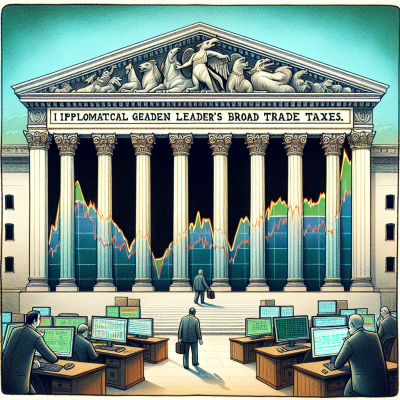
Stock Market Faces Turbulence as Tariffs Take Center Stage
The U.S. stock market opened the week on shaky footing as Wall Street reacted to the implementation of sweeping new tariffs introduced by former President Donald Trump. This bold move reverberated through the markets on Monday morning, with futures tied to the Dow Jones Industrial Average, S&P 500, and Nasdaq Composite all trending downward.
Heightened Investor Anxiety Over Long-Term Economic Fallout
President Trump’s new tariff policy, dubbed by analysts as some of the most impactful in recent memory, ushered in uncertainties that rattled global investors. The tariffs—targeted primarily at China and specific sectors in Europe—signal a renewed shift toward economic protectionism, igniting concerns over global supply chain disruptions, rising consumer costs, and strained international trade relations.
“Markets are now pricing in the potential for retaliatory measures and the downstream impact these duties will have on corporate earnings,” said a senior equity strategist from a leading Wall Street firm.
Market Snapshot: Futures Signaling Rocky Start
As trading began early Monday, the major indexes reflected unease:
- Dow Jones Industrial Average futures dropped over 150 points in pre-market action.
- S&P 500 futures declined about 0.5%, reflecting cautious sentiment among blue-chip investors.
- Nasdaq futures fell nearly 0.7%, weighed down by tech giants with global manufacturing and distribution exposure.
The retreat in stock futures suggests traders are bracing for heightened volatility, particularly in sectors reliant on global trade including technology, automotive, and consumer electronics.
Major Sectors Under Pressure
Investors are pulling back from some of the high-flying sectors that gained momentum earlier this year. The uncertainty has hit:
- Technology stocks: Many U.S. tech firms source components from overseas, and the new tariffs could raise production costs significantly.
- Manufacturing: Companies in aerospace and heavy machinery could face hurdles due to increased part and raw material costs.
- Retail and Consumer Goods: Higher import costs may be passed down to consumers, resulting in softer demand.
Economic Fallout and Corporate Response
While the full impact of Trump’s tariffs may take several months to unfold, companies are already beginning to review their supply chains and business strategies. Some may explore rerouting operations to tariff-exempt regions or reshoring certain manufacturing capabilities to the U.S., though such moves often require time and capital investment.
Several multinational corporations have announced plans to adjust earnings projections downward, citing expected tariff-related headwinds.
Global Markets React
The effects of U.S. economic policy were not confined to domestic markets. Asian and European stocks also mirrored the unease:
- Shanghai Composite Index: Slipped over 1.2% amid fears of a prolonged trade clash.
- Germany’s DAX: Dropped nearly 0.9% as exporters braced for reduced demand from American buyers.
- FTSE 100 (UK): Experienced modest losses as commodity-linked stocks declined.
Investors across the globe fear that a trade dispute could slow the already fragile global economic recovery, causing ripple effects that dampen growth in emerging markets, commodities, and currencies.
Expert Commentary: Assessing the Road Ahead
Market watchers are keeping a close eye on possible retaliatory measures from affected countries. A brewing tit-for-tat approach raises fears of a wider trade war, something most economists agree would be a major drag on global growth.
Economic think tanks have warned that if fully extended, the tariffs could trim U.S. GDP by as much as 0.5% over the next two years. “It’s not just about the cost of imported goods. It’s about the knock-on impact on confidence, investment, and job creation,” noted a chief economist from a major New York firm.
Safe Havens Shine Amid Market Unease
While stock markets falter, investors are seeking safety in traditional havens:
- Gold prices: Edged higher by 1.3% as investors shifted capital toward tangible assets.
- U.S. Treasury yields: Fell as bond prices climbed, signaling a classic flight to safety scenario.
- U.S. Dollar: Strengthened modestly against a basket of global currencies as investors bet on central bank interventions.
Conclusion: A Market in Flux
The imposition of Trump’s massive tariffs has jolted financial markets, triggering a storm of investor concern regarding economic stability and trade relationships. With stock futures down and uncertainty looming large, all eyes are now on the White House and international trade partners to determine whether further escalation—or resolution—will follow.
For investors, the key strategy in coming weeks may be caution and diversification, as the market processes new information and recalibrates expectations for the rest of the year.
Stay tuned as the story continues to develop in what’s shaping up to be a defining chapter for markets in 2025.


Leave a Reply